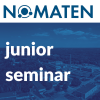JUNIOR SEMINAR on OCT 19th: Sn oxycarbide – structural and functional characterization of biocoatings
Silicon oxycarbide – structural and functional characterization of novel biocoatings
Application of vibrational spectroscopy and imaging in organic and inorganic samples analysis
Magdalena Gawęda PhD - Gdansk University of Technology · Faculty of Electronics, Telecommunications and Informatics, Doctor of Chemistry
LINK: https://gotomeet.me/ncbjmeetings/nomaten-seminar
Tuesday OCT 19 2021 at 1PM CET (13:00)
Silicon oxycarbide (SiOC) (sometimes slightly confusingly called “black glass”) is a group of amorphous or glass crystalline materials. They consist of an amorphous silica matrix with implemented carbon in two forms: ions replacing part of oxygen ions (anionic substitution) and so-called “free carbon” phase – turbostratic graphite of varying ordering degree. This implementation results in drastic changes in the properties compare to the silica. Although there are several paths of preparation of this material, the most efficient one is preparation as polymer derived ceramics (PDCs). Commercially available or self-synthesised organometallic precursors undergo high-temperature treatment (ceramization) to transform polymers into ceramic material. The use of self-prepared compounds enables the additional opportunity of implementation of cationic modifications. In my presentation, I will present an extended structural and microstructural analysis of coatings prepared based on SiOC and SiMOC (where M stands for mentioned cationic dopants: phosphorus, aluminium, boron and cerium) on steel and titanium substrates. Along with this examination, several functional properties were analysed to evaluate the suitability of the materials for application in medicine, especially as the protective coatings for metallic implants, e.g. corrosion resistance, mechanical parameters, antibacterial properties, bioactivity and biocompatibility. As a result, preparation of SiOC and SiMOC (M: P/P,Al/P,B/Ce) amorphous coatings with satisfying physicochemical and functional properties was confirmed.
In my work, I strongly depend on various spectroscopic methods, focusing on Raman and infrared spectroscopy, to obtain information on the structure and chemical composition of the obtained ceramic materials as well as biological samples (cells and tissues). Additionally, the use of imaging techniques, followed by chemometric analysis, gives extensive knowledge of the spatial distribution of the particular phases.









